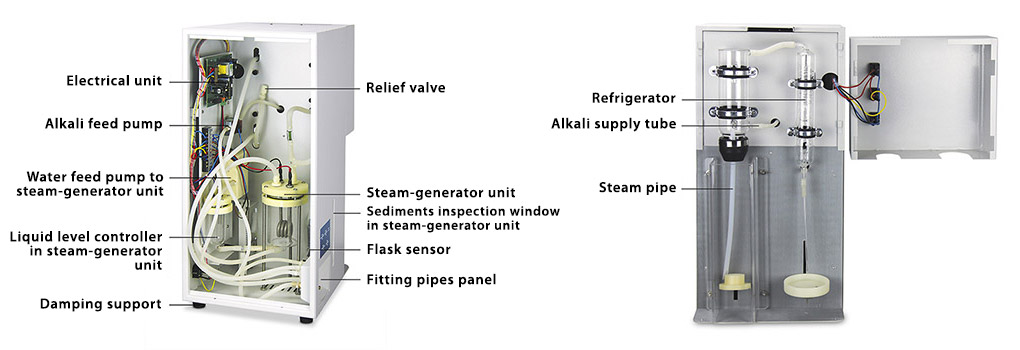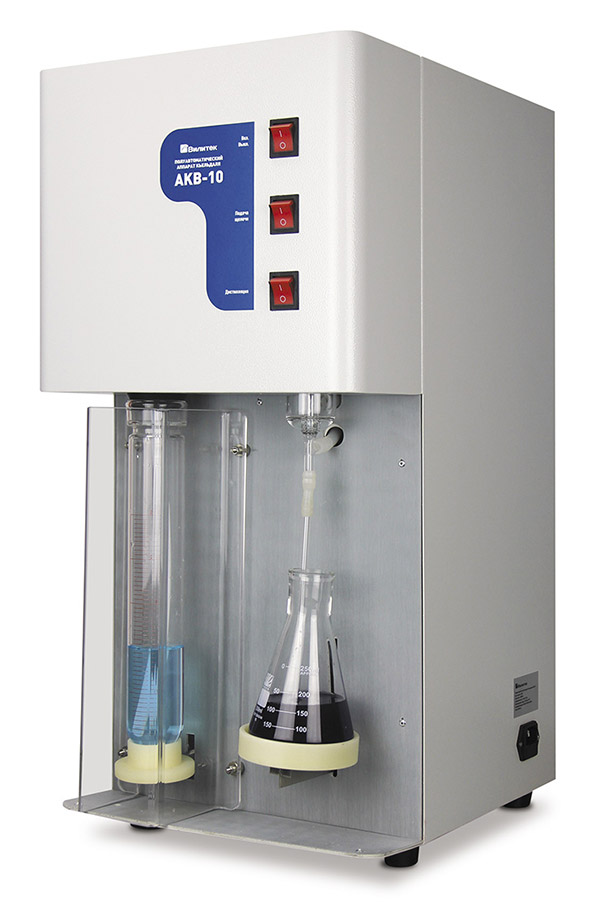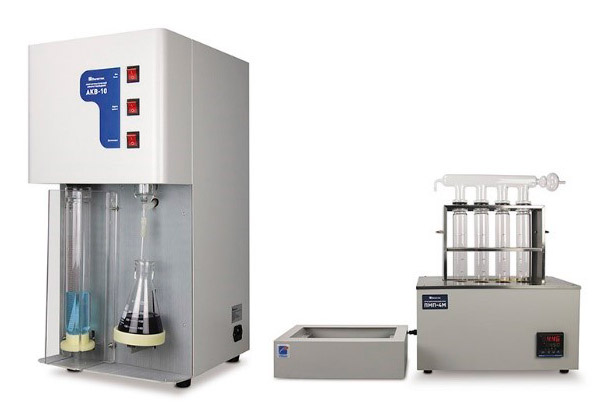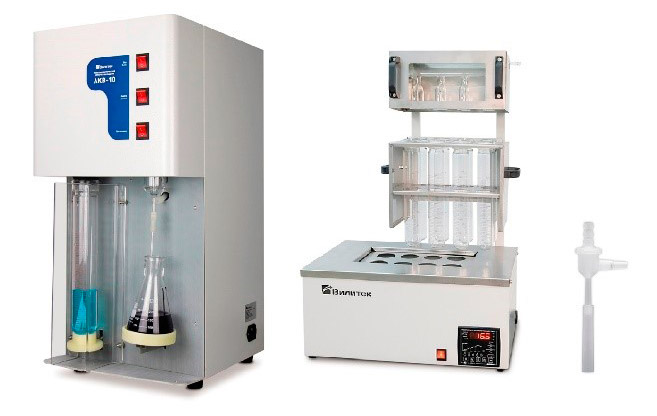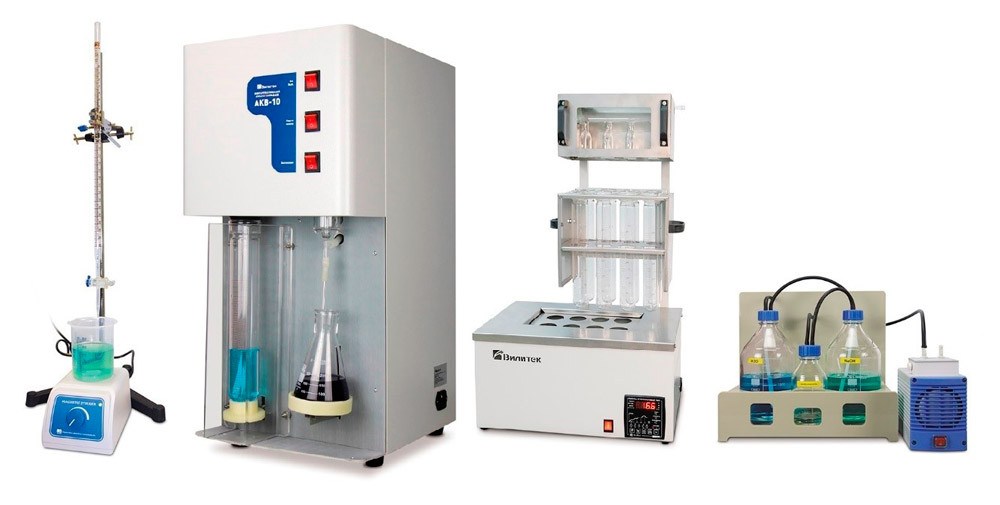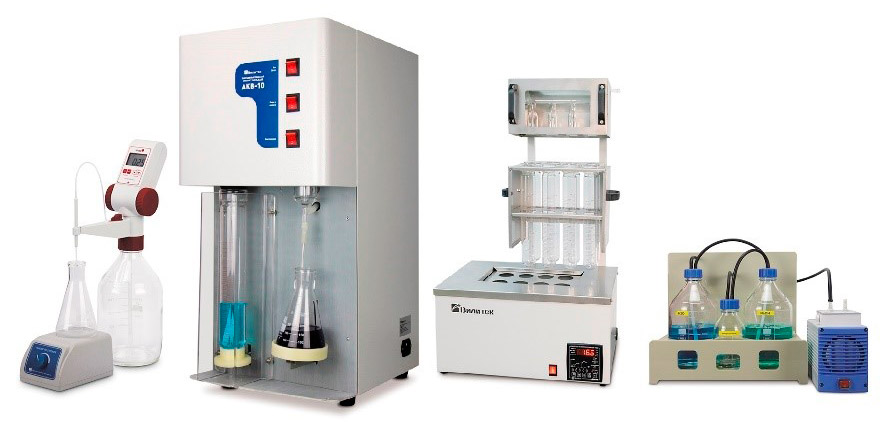- Home
- >
- Products
- >
- Analyzers of protein, fat, fiber and moisture concentration
- >
- AKV-10 semi-automatic Kjeldahl apparatus
AKV-10 semi-automatic Kjeldahl apparatus
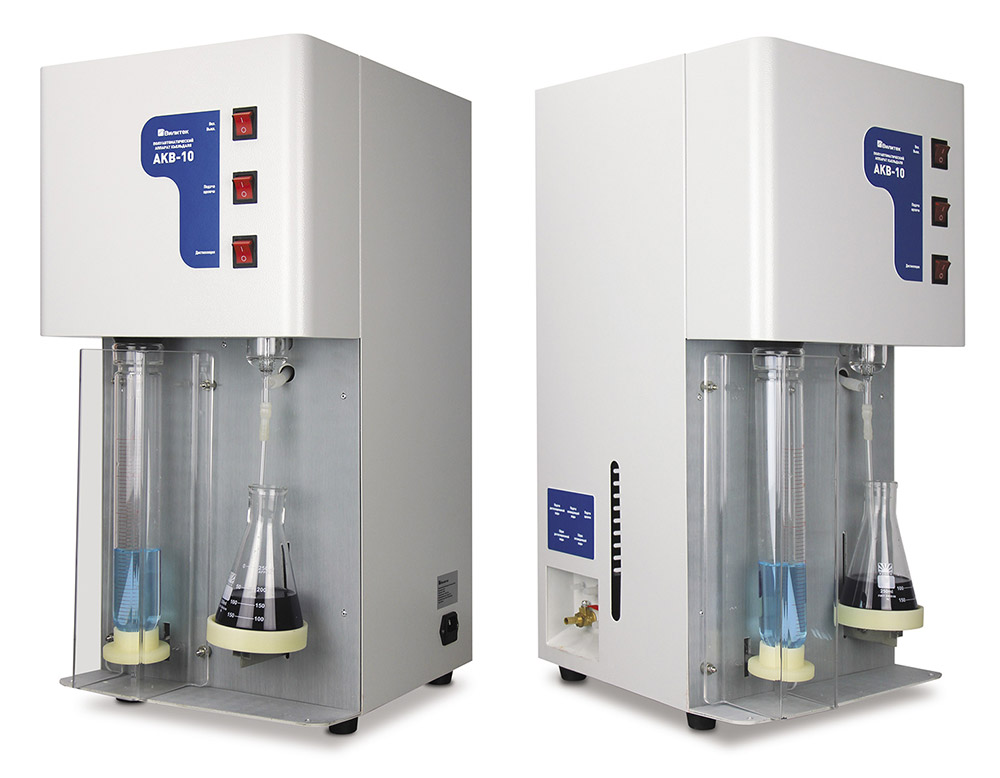 Firstly, AKV-10 Kjeldahl apparatus for protein analysis is designed to replace glass devices assembled by laboratory personnel on their own. The simple design and operation, minimum of electronics, but at the same time the convenience in operation and maintenance make this device to be an excellent choice for laboratories with a small amount of analysis, but who want to reduce the labour costs of assembly, disassembly, preparation for operation of well-assembled systems for ammonia distillation by Kjeldahl method. The AKV-10 apparatus is used to measure protein weight parts in accordance with standards for various food products and drinks, in particular, in cottage cheese, sour cream, milk, beer, crops, canned meat, cereals, etc., animal feed and compound animal feedstuff as well as nitrogen content in fertilizers and soil samples.
Firstly, AKV-10 Kjeldahl apparatus for protein analysis is designed to replace glass devices assembled by laboratory personnel on their own. The simple design and operation, minimum of electronics, but at the same time the convenience in operation and maintenance make this device to be an excellent choice for laboratories with a small amount of analysis, but who want to reduce the labour costs of assembly, disassembly, preparation for operation of well-assembled systems for ammonia distillation by Kjeldahl method. The AKV-10 apparatus is used to measure protein weight parts in accordance with standards for various food products and drinks, in particular, in cottage cheese, sour cream, milk, beer, crops, canned meat, cereals, etc., animal feed and compound animal feedstuff as well as nitrogen content in fertilizers and soil samples.
The Kjeldahl method to measure protein weight parts in food products includes the following steps: mineralization (burning) of the analysed sample of food product with sulfuric acid, resulting in the formation of ammonium sulphate, then it is converted to ammonia, which is distilled into a boric acid solution with water vapor; titration of the resulting solution; and calculation of protein weight in the test sample.
Brief technical characteristics of the AKV-10 Kjeldahl apparatus:
- Power supply: 220 V, 50 Hz.
- Power consumption: 1,000 W.
- Cooling water flow: 3 L/min, 20 °C.
- Overall dimensions (LxWxH): 375×320×675 mm.
- Weight: 20 kg.
Operation procedure for AKV-10 Kjeldahl used for ammonia is as follows:
- Turn on the apparatus by pressing a key and allow the built-in steam generator to warm up for about 10 minutes before starting work (only required before first start of the apparatus);
- Measure 20 ml of sodium hydroxide;
- Measure 25 ml of boric acid mixed with the indicator in a conical flask and place it in the appropriate place on the apparatus;
- Place Kjeldahl flask with mineralized sample in the appropriate place in apparatus and close the transparent door;
- Press the alkali supply key and put the corresponding suction tube in a glass with a measured amount of alkali, turn off the alkali supply after the entire measured volume is fed into Kjeldahl flask;
- Press the distillation key and carry out the distillation for 10 minutes;
- Carry out the titration of the resulting solution with hydrochloric acid and recalculate protein weight parts.
In contrast to the more advanced automatic model AKV-20, the AKV-10 semi-automatic Kjeldahl protein analyzer does not dispense alkali, does not preliminary dilute the mineralized sample with distilled water and does not have a timer to turn off the distillation process. The necessary (obviously excessive) alkali amount is usually 20 ml, it is measured manually, and the AKV-10 apparatus with the help of the built-in pump and a special tube collects the previously measured liquid and transfers it to Kjeldahl flask. The accuracy of protein weight parts measuring by Kjeldahl method is mainly affected by the quality of sample preparation and the completeness of distillation. AKV-10 apparatus provides high-quality and complete distillation of ammonia, which can easily be controlled. Thus, the lack of some automation functions in AKV-10 apparatus affects only the number of manual operations, but does not affect the measurement accuracy.
Design of AKV-10 Kjeldahl apparatus:
To demonstrate the internal arrangement, the apparatus is shown with the front and rear panels removed, it is not recommended to remove the panels during operation.
For preliminary samples homogenization, it is recommended to use a rotary homogenizer with a four-blade knife, knife angular rotation speed is 1,000-10,000 per min, including a container with a capacity of 1.0 dm, the most optimal model is a rotary homogenizer with a HMB-312 four-blade knife. As a container for this homogenizer, it is allowed to use a 1,000 ml beaker. For samples mineralization before distillation in AKV-10 Kjeldahl apparatus it is recommended to use PMP-M digestors.
Sets of equipment for protein weight parts measuring by Kjeldahl method based on the AKV-10 semi-automatic Kjeldahl apparatus
AKV-10 semi-automatic Kjeldahl apparatus
Complete set:
- AKV-10 Kjeldahl separate semi-automatic distiller.
AKV-10 Kjeldahl apparatus. Start package
Complete set:
- AKV-10 semi-automatic Kjeldahl apparatus.
- PMP-4M digester.
- Water-jet pump (c/w digester).
- Four Kjeldahl flasks (c/w digester).
AKV-10 Kjeldahl apparatus. Optimal package
Complete set:
- AKV-10 semi-automatic Kjeldahl apparatus.
- PMP-8M digester.
- Water-jet pump (c/w digester).
- Eight Kjeldahl flasks (c/w digester).
AKV-10 Kjeldahl apparatus. Advanced package
Complete set:
- AKV-10 semi-automatic Kjeldahl apparatus.
- PMP-8M digester.
- Gas waste system based at membrane chemically-resistant SKB-4 vacuum pump.
- Water-jet pump (c/w digester).
- Eight Kjeldahl flasks (c/w digester).
- Manual titration system based at TUR-1 magnetic stirrer.
AKV-10 Kjeldahl apparatus. Advanced plus package
Complete set:
- AKV-10 semi-automatic Kjeldahl apparatus.
- PMP-8M digester.
- Gas waste system based at membrane chemically- resistant vacuum pump SKB-4.
- Water-jet pump (c/w digester).
- Eight Kjeldahl flasks (c/w digester).
- Titration system based at automatic burette and magnetic stirrer.
AKV-10 Kjeldahl apparatus. Expanded package
Complete set:
- AKV-10 semi-automatic Kjeldahl apparatus.
- PMP-8M digester.
- Exhaust hood.
- Gas waste system based at membrane chemically- resistant SKB-4 vacuum pump.
- Water-jet pump (c/w digester).
- Eight Kjeldahl flasks (c/w digester).
- Titration system based at automatic burette and magnetic stirrer.
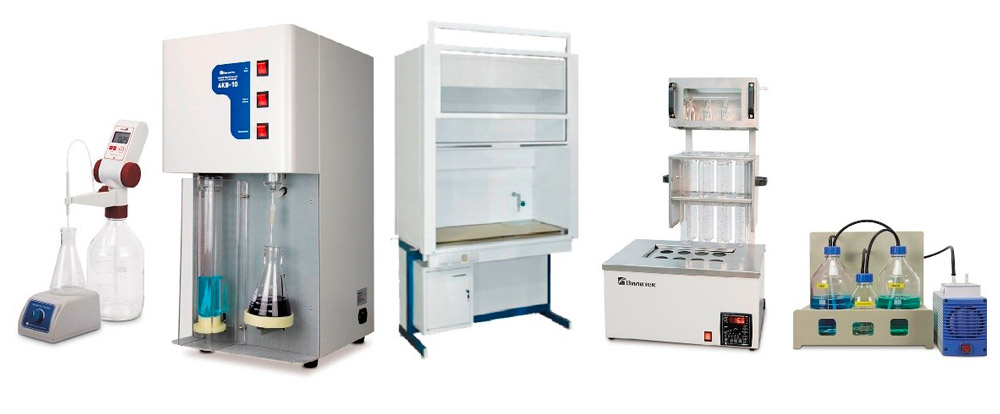
To perform the Kjeldahl protein analysis in accordance with current standards, you may need the following additional equipment:
- Laboratory balance with permissible absolute error of a single weighing ±0.0001 g. We recommend using the Ohaus PA114C analytical balance.
- Laboratory balance with a permissible absolute error of a single weighing of ±0.01 g. We recommend using the Ohaus STX222 laboratory balance.
- Rotary homogenizer with a four-blade knife, knives’ rotation speed is 1,000-10,000 rpm, including a container with a capacity of 1.0 dm. We recommend using the laboratory homogenizer HT Machinery HM-302.
- Thermostatically controlled water bath allows maintaining the temperature from 0 °C to +100 °C with a permissible error of ±2 °C. We recommend using the Digisystem WB-500D laboratory unstirred water bath.
- Laboratory hot air oven providing temperature maintenance from +50 °C to +150 °C with a permissible error of ±2 °C, we recommend using the Digisystem DSO laboratory hot air ovens.

